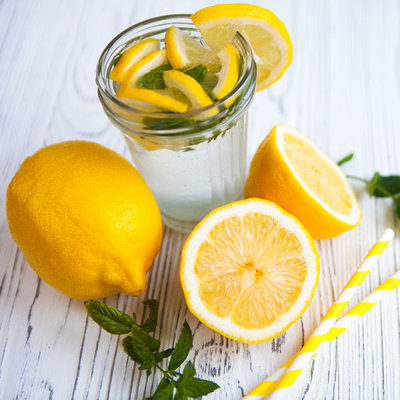
Lemon
What is a Lemon?
Lemon is a bright, yellow citrus fruit that typically has a sour taste. It adds a bright flavor to foods, drinks, juices, and beverages. It has low-calorie content and high vitamin C content. This fruit grows predominantly in mild and warm climates and can be juiced, as well as preserved.
Some common ways to use this citrus fruit in the kitchen are:
- Sauces and Desserts
- Accompaniment in poultry food
- Baked goods
- Garnish and Flavoring in foods
Origin of lemons
While no one knows the exact origin of this unique fruit, the word “lemon” came from the Middle English word “limon” between 1350 and 1400. Sources suggest that this fruit may have come from the Northwest of India, as people in this region have been cultivating it for over 2,500 years. Sometime after 100 CE, Arab traders introduced this citrus fruit to Africa and the Middle East. Historians believe that the fruit was introduced to Southern Italy around 200 CE. Up until the 10th century, people didn’t see this citrus fruit as food and only cultivated it for decoration and ornamental purposes.
These fruits made their way into Spain in the 1100s, which the Arabs were also responsible for. Later, crusaders from Palestine brought this fruit to the remainder of Europe, where the first use of it in food was in the 15th century. Christopher Columbus would later introduce this fruit to the new world when he brought the seeds into Hispaniola. Spanish conquest also played a significant role in spreading this fruit around the world.
In the 18th century, people in California planted this fruit and further south in Florida locals started using it for culinary purposes. The cultivation of this fruit experienced tremendous growth in Florida and California during this period. In 1953, the need for frozen concentrate and natural cold-press oil sparked up the production of this citrus fruit again. Today, this fruit has found its way into many dishes and treats.
Nutrition
In 58g serving of this fruit (without the rind), you will get the following nutrient content:
- Calories: 17
- Fat: 0.2g
- Fiber: 1.6g
- Sugars: 1.5g
- Protein: 0.6g
- Carbohydrates: 5.4g
This tasty fruit has many significant health benefits. Here are some of them:
- The vitamin C in this fruit reduces your risk of stroke or developing heart disease.
- Plant compounds in this fruit can help you to lose weight.
- It can protect you against anemia because of its high iron content.
- It might be capable of preventing the development of kidney stones.
- This fruit’s pulp can help your digestive system work properly.
- It contains substances that reduce the risk of cancer.
However, this fruit has its side effects, if you consume it in excess.
- Its juice can erode tooth enamel. To avoid this, drink this juice with a straw and brush your teeth afterward.
- The high acidity of this fruit may worsen ulcers.
- It can also irritate mouth sores.
Use
Lemons can only last one week in your kitchen cabinet. An excellent way to increase the shelf life of this fruit is to place it in a plastic bag and keep it in the fridge. This fruit can last up to one month this way. Furthermore, the fruit can stay in the freezer for three to four months.
Commercial production
People grow lemons on a large scale with many hectares of land. Cultivation is mostly done on light loam, well-drained soil. There are many varieties of this fruit in the U.S. Some of them are good for juice, while others are better for oil. The climatic conditions needed for their cultivation also differ. The optimal conditions for this fruit’s production are:
- Sowing Temperature: 77 to 86°F.
- Rainfall: 29.5 to 78.7 inches
- Harvesting temperature: 77 to 86°F.
- PH range: 5.5 to 7.5
The following steps summarize the commercial production of this citrus fruit:
- Land preparation: This involves plowing and leveling the soil.
- Sowing: This refers to the actual propagation procedure. The two main methods of propagation are budding and air layering. Producers perform this, taking into consideration the sowing depth and plant spacing required.
- Farmers perform fertilizer application, irrigation, pruning, and weed control to produce healthy fruits.
The United States produced 888,000 tons of this fruit in 2018.
Lemon recipes
This fruit can be enjoyed in desserts, juices, cakes, cocktails, sauces, salad dressings, and many other dishes. Here are some popular recipes:
- Lemon posset with sugared-almond shortbread
- Poppyseed cupcakes
- Rhubarb curd cake
- Raspberry polenta cake
- Marmalade
FDA regulation
The Food and Drug Administration classifies lemon as a raw agricultural commodity. The organization regulates its growing, harvesting, and packing. The FDA also has a standard of identity for this citrus fruit juice, which it defines as “the unfermented juice, obtained by a mechanical process from this fruit when matured and from which seeds and excess pulp are removed.” They go on to detail how this fruit juice should be packaged, preserved, and labeled.
References
West, Helen. “6 Evidence-Based Health Benefits of Lemons.” healthline.com, Healthline Media, 7 Jan. 2019, www.healthline.com/nutrition/6-Lemon-health-benefits.
Laura, Krebs-Holm. “Lemons: Health Benefits, Nutrition, and Side Effects.” emedihealth.com, Emedihealth, 20 June 2020, www.emedihealth.com/Lemon-benefits.html.
“CFR – Code of Federal Regulations Title 21.”, Accessdata.fda.gov, U.S Food & Drug Administration 1 Apr. 2019, www.accessdata.fda.gov/scripts/cdrh/cfdocs/cfcfr/CFRSearch.cfm?fr=146.114.
